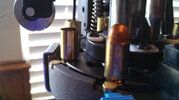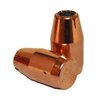jmorris
Member
- Joined
- Sep 30, 2005
- Messages
- 24,202
I am under the impression that when using a progressive press, one needs to flare the case lips wider, and as a result - crimping is more necessary.
And that the wider flare and crimping step is due to progressive presses having more slop and being less forgiving of misalignments due to their speed of operation.
Is this assumption correct?
EDIT: Context - automated bullet feeder.
Some dies can be less forgiving on progressives because they don’t have much radius on their entrances but no, you don‘t across the board need more or even any flair. It’s going to depend on what you are loading as well as what kind of bullet and feeder you are running.
Using a GSI feeder, for example, with my cast and coated bullets, this is how much flare I use.

That empty case is about to have a perfectly held bullet seated into it on the next down stroke and the near bullet will be “crimped”.
There is absolutely zero flare/bell on these .223 cases as these 55gn FMJ BT bullets are dropped on top.

KISS fed 1050
A number of variables effect results though.
If seating bullets by hand, I can imagine similar behavior with a progressive press.
How many of you don’t use a crimping step on your progressives, when using a bullet feeder?
I often don’t crimp rifle rounds bullet feeder or not. My “crimp” on many pistol rounds would be more accurately called the “unflare“ step. I almost never apply a crimp that disrupts the bullet shape and many do not have a cannelure to crimp into. So I remove the flare but do not shove the case into the bullet, swaging the bullet to a smaller diameter.



